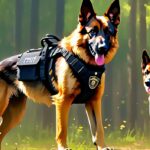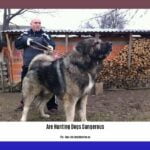Welcome to “Unveiling the Canine Curiosities: 10 Weird Facts About Dogs,” a fascinating journey into the quirks and peculiarities of man’s best friend. In this captivating collection, we will delve into the mysterious world of canine behavior and psychology, uncovering strange and surprising facts that will leave you marveling at the incredible diversity and complexity of our four-legged companions. From their extraordinary senses to their bizarre habits, get ready to discover a side of dogs you never knew existed. So, without further ado, let’s embark on this intriguing exploration of the fascinating and sometimes downright bizarre world of dogs.
Key Takeaways:
- Dogs have an impressive ability to understand up to 200 words and gestures.
- All dogs, just like humans, dream. Some dogs dream more than others.
- Dogs are one of the few species that display altruistic behavior.
- All puppies are born blind and deaf.
- Yawning is contagious for dogs too, just like for humans.
- A dog’s nose print is as unique as a human’s fingerprint.
- Unlike humans, female dogs don’t go through menopause.
- The Labrador Retriever holds the record for being on the AKC’s top 10 most popular breeds list for the longest period.
- Approximately 45% of dogs in the United States sleep in their owners’ beds.
- Dogs have a natural instinct to dig, creating cool spots during summer and warm sleeping places in winter.
- Dogs didn’t develop facial expressions resembling humans’ until they were domesticated.
- Dogs can see in color, although not as vividly as humans.
Sources:
– ElleVet Sciences
– American Kennel Club
10 Weird Facts About Dogs

Have you ever wondered what makes dogs so fascinating? These loyal and endearing creatures never fail to amaze us with their peculiar behaviors. From their extraordinary sense of smell to their unique ways of communication, there’s always something new to discover about our four-legged friends. In this article, we delve into the canine curiosities and unveil 10 weird facts about dogs that will leave you astounded.
1. Dogs Can Understand as Many as 200 Words and Gestures
While we often marvel at our furry companions’ ability to comprehend basic commands like “sit” and “stay,” their language skills go well beyond our expectations. Studies have shown that dogs can understand a vast vocabulary of up to 200 words and gestures. Whether it’s a simple nod or a complex set of hand signals, they have an astonishing ability to interpret and respond to our cues.
2. All Dogs Dream – Some More Than Others
Just like us, dogs experience the wild adventures of dreamland. However, their dreams may vary in intensity and duration. Some pooches have more vivid dreams than others, often accompanied by subtle twitching or paw movements. So the next time you see your furry friend falling into a deep sleep, rest assured that they’re off on an exciting imaginary escapade.
3. Dogs Are One of Few Species That Display Altruistic Behavior
Altruism, the act of selflessly helping others, is a quality that humans often pride themselves on. But did you know that dogs also possess this admirable trait? Dogs are known to exhibit acts of altruism towards their human companions as well as other animals. Whether it’s comforting a crying child or rescuing a distressed fellow canine, their capacity for empathy and compassion is truly remarkable.
4. All Puppies Are Born Blind and Deaf
As cute as those fluffy little puppies may be, they come into this world completely blind and deaf. It takes a few weeks for their eyes and ears to fully develop, allowing them to perceive the world around them. Until then, these adorable bundles of joy rely on their sense of touch and their keen sense of smell to navigate their surroundings and bond with their mother.
5. Yawning Is Contagious – Even for Dogs
You’ve probably noticed that yawning tends to be contagious among humans, but did you know that dogs can catch a case of the yawns too? It’s true! Research has shown that dogs are susceptible to contagious yawning, just like us. So the next time you let out a big yawn, be prepared for your canine companion to join in on the sleepy symphony.
6. A Dog’s Nose Print Is Unique, Much Like a Human’s Fingerprint
We’re all familiar with the concept of identifying individuals through their fingerprints. Well, dogs have their own unique form of identification as well – their nose prints! Just like how no two human fingerprints are alike, no two dog nose prints are identical. This remarkable feature has even been utilized by some organizations for canine identification purposes.
7. Female Dogs Don’t Go Through Menopause
In the animal kingdom, menopause is a phenomenon unique to humans and a few select species. Interestingly, female dogs do not experience menopause. Unlike their human counterparts, female dogs can continue to reproduce throughout their entire lives. This adds another layer of complexity to the already fascinating world of canine reproduction.
8. The Labrador Retriever Has Been on the AKC’s Top 10 Most Popular Breeds List for Longer Than Any Other Breed
Labrador Retrievers have undoubtedly won over the hearts of many dog lovers, and their popularity is nothing short of extraordinary. In fact, the Labrador Retriever has claimed and maintained a spot on the American Kennel Club’s top 10 most popular breeds list for a longer duration than any other breed. Their friendly nature, intelligence, and versatility make them a beloved choice for families around the world.
9. Forty-Five Percent of U.S. Dogs Sleep in Their Owner’s Beds
When it comes to bedtime arrangements, dogs often hold a special place in our hearts – and in our beds. Surprisingly, a whopping 45% of dogs in the United States curl up and snooze right alongside their owners. The close bond between humans and canines extends even to the realm of sleep, providing comfort and companionship to both parties during the night.
10. Dogs Have a Natural Instinct to Dig, Creating Cool Spots in the Summer or Warm Places to Sleep in the Winter
Have you ever wondered why your dog can’t resist digging up your garden or creating cozy holes to curl up in? Well, it turns out that dogs have a natural instinct to dig. Beyond being a playful activity, digging serves a practical purpose for our canine friends. They dig to create cool spots to escape the summer heat or warm burrows to keep cozy during the winter months.
As you can see, our furry companions are full of surprises. From their incredible language comprehension to their altruistic tendencies, dogs continue to astonish and captivate us with their unique qualities. So the next time you find yourself in the company of a dog, take a moment to appreciate these weird and wonderful traits that make them truly remarkable.
Here are two interesting articles for you to check out:
10 weird facts about cats – Did you know that cats have five toes on their front paws but only four on their back paws? Discover more fascinating and unusual facts about our feline friends in this captivating article!
10 most important facts about vets – Have you ever wondered what it takes to be a veterinarian? Learn about the crucial role these dedicated professionals play in keeping our pets healthy and happy. Click here to explore the ten most important facts about vets.
Don’t miss out on these intriguing reads!
Dogs: Masters of Social Hierarchy in Packs

Dogs are fascinating creatures that have an innate ability to form complex social hierarchies and exhibit pack behavior. As avid canine enthusiasts, we marvel at their unique dynamics and intricate relationships within the pack. Let’s delve into the captivating world of dog social structures and uncover 10 weird facts about dogs.
Understanding Canine Social Hierarchies
Dog social hierarchies have long been a topic of interest among researchers and dog trainers. The dominance theory suggests that canine behavior revolves around dominance and hierarchy. However, to truly comprehend how dogs establish and maintain social hierarchies, we must observe their behaviors and interactions.
A study conducted by researchers at Utrecht University in the Netherlands shed light on dog behavior and social hierarchies. They closely observed a group of Dutch dogs and analyzed their interactions. Although the study focused on a specific group, its findings provide invaluable insights that can be generalized to our own dogs.
Peering into the Pack Structure
At the heart of canine social organization lies the pack. Just like their wild ancestors and wolves, dogs exhibit stable hierarchies within their packs. Domestic dogs adapt well to living in groups and establish flexible arrangements within their social structure.
However, it is essential to dispel the notion of a strict linear hierarchy in domestic dogs. While higher-ranking dogs may have certain privileges, the social structure is far from being a simple ladder. Dog social hierarchies are intricate and can vary depending on individual dogs and their interactions.
The Complexity of Dog Hierarchy
Unraveling the intricacies of how dogs perceive and express rank is an ongoing research area. The lack of data and the controversial nature of the dominance theory present challenges in understanding dog social hierarchies more comprehensively. It is crucial for further research to explore the frequency and structure of dominant-subordinate relationships among dogs.
By keenly observing and studying dog interactions, we can gain insight into their complex social behaviors. Understanding how dogs form social hierarchies enables us to better comprehend our own dogs’ behaviors and enhance our interactions with them.
With our newfound knowledge about dog social hierarchies, let’s explore some peculiar and intriguing facts about our furry friends.
Weird Facts About Dogs
- Dogs display an exceptional knack for understanding and forming complex social hierarchies within their packs, mirroring their wild ancestors and wolves. Their ability to adapt and establish flexible arrangements showcases their remarkable versatility.
- While higher-ranking dogs may enjoy certain privileges, such as breeding opportunities, it’s important to note that the canine social structure is far from a rigid and linear hierarchy. Each dog’s role and rank can vary depending on various factors and interactions.
- Dog hierarchy is often misunderstood, with the dominance theory widely debated among experts. The controversy surrounding this theory highlights the need for further research to gain a more nuanced understanding of dog social hierarchies.
- In domestic dogs, social structures can vary significantly based on individual personalities and environmental factors. This complexity adds depth to their social dynamics, making every dog pack a unique web of relationships.
- Dogs use various behaviors and cues to establish and maintain their position within the pack. These cues can range from body language and vocalizations to posturing and subtle movements.
- Pack behavior is deeply rooted in dogs’ instincts, emphasizing their natural inclination to form social hierarchies. This behavior helps facilitate cooperation, hunting, and overall survival within the pack.
- Canine social hierarchies provide stability and organization within the pack, minimizing conflicts and promoting efficient group dynamics.
- Understanding dog social hierarchies can be beneficial not only for the dogs themselves but also for dog owners and trainers. Recognizing and respecting the existing social dynamics can lead to smoother interactions and more harmonious relationships.
- Dog social hierarchies can change and evolve over time, influenced by factors such as age, health, and changes in the pack composition. As dogs grow and mature, their roles within the hierarchy may shift.
- Despite the complexity of dog social hierarchies, it is important to remember that each dog is unique. While general patterns and tendencies exist, individual personalities and experiences play a significant role in shaping a dog’s position within the pack.
Key Takeaways:
– Dogs are masters of forming complex social hierarchies, exhibiting remarkable adaptability within their packs.
– The conventional concept of dominance and a linear hierarchy oversimplifies dog social structures.
– Understanding dog social hierarchies is an ongoing research area that requires further exploration.
– Canine social hierarchies vary based on individual personalities and environmental factors.
– Dog social structures provide stability, cooperation, and organization within the pack.
– Recognizing and respecting dog social dynamics promotes better interactions and relationships.
– Dog social hierarchies can change and evolve over time, influenced by various factors.
– Each dog’s unique personality and experiences shape their position within the hierarchy.
Sources:
– The Wildest: Understanding Canine Social Hierarchies
– MSD Veterinary Manual: Social Behavior of Dogs
Understanding Canine Social Hierarchies
Dogs have always fascinated us with their behaviors and interactions. One aspect that captures our attention is how dogs establish and understand social hierarchies. While the concept of dominance and hierarchy in dogs has been extensively debated, researchers continue to study their behaviors to shed light on this topic.
A study conducted by researchers at Utrecht University in the Netherlands focused on observing a group of Dutch dogs to gain insight into their social behaviors. The findings of this study provide valuable information that can help us understand how dogs interact with one another.
In the world of dogs, social structures revolve around packs. Dogs, like their wild relatives, wolves, establish stable hierarchies within their packs. Domestic dogs are adaptable to living in groups and can create flexible arrangements within their social structure.
It is important to note that the idea of dominance and hierarchy in domestic dogs is often misunderstood. While higher-ranking dogs may have certain privileges, such as breeding rights, the notion of a strict linear hierarchy is not completely accurate. Dog social structures are complex and can vary depending on individual dogs and their interactions with each other.
The understanding of how dogs establish and express rank is still an ongoing area of research. The limited data available and the controversial nature of the dominance theory hinder a more detailed discussion on dog social hierarchies. Further research is needed to explore the frequency and structure of dominant-subordinate relationships among dogs.
By observing and studying dog interactions, we can gain valuable insights into their social behaviors. Understanding the complexities of canine social hierarchies allows us to better comprehend our own dogs’ behaviors and enhance our interactions with them.
Key Takeaways:
– Dogs establish social hierarchies within their packs, similar to their wild relatives.
– The concept of dominance and hierarchy in domestic dogs is often misunderstood.
– Dog social structures are complex and can vary depending on individual dogs and their interactions.
– Further research is needed to fully understand dog social hierarchies and their implications.
Sources:
– The Wildest: Understanding Canine Social Hierarchies
– MSD Veterinary Manual: Social Behavior of Dogs
Unveiling the Canine Curiosities: 10 Weird Facts About Dogs
Dogs have always been fascinating creatures, captivating us with their unique behaviors and expressions. One peculiar aspect of our four-legged friends is their distinct way of communicating through body language, vocalizations, and even facial expressions. In this article, we will delve into this intriguing topic and shed light on some of the lesser-known facts about dog communication.
Dogs Speak Without Words
Communication among dogs primarily relies on non-verbal cues, making body language the cornerstone of their communication system. Dogs use a combination of tail carriage and motion, ear and eye position, body position and movement, and facial expressions to convey their emotions and intentions. [5. Dogs have a distinct way of communicating through body language, vocalizations, and even facial expressions.]
Decoding Aggression and Discomfort
One important aspect of dog communication is food aggression. Dogs may exhibit various signs of aggression, including stiffening of their body, showing teeth, growling, snapping, or biting when it comes to food. It is crucial to recognize these signals and address them appropriately to ensure the safety of both humans and dogs.
Another form of communication often misunderstood is jumpy/mouthy behavior. When dogs display this behavior, it can be a sign that they are uncomfortable or unsure about a person’s touch. It is essential to respect their boundaries and provide them with a calm and safe environment.
Training and Improving Communication
Training and motivation play a crucial role in enhancing dog communication skills. Shelter staff and volunteers can learn effective training techniques to help improve dogs’ overall behavior and communication. By providing the necessary training, we can ensure that shelter dogs have a better chance of finding loving homes.
Overcoming Fear
Fear of people is another communication behavior observed in dogs. Dogs that exhibit fear should be reassessed periodically to address their fears and provide them with the necessary support. Understanding their communication signals and providing a safe and nurturing environment can help them overcome their fears and build trust.
Environmental Exploration
Dogs who have not lived in a home setting may engage in certain behaviors such as jumping on desks and furniture. This behavior is often a form of exploration and entertainment for them. Creating an enriching environment that satisfies their curiosity can help prevent these behaviors.
Different Species, Common Language
Dogs, as domestic animals, communicate not only with their fellow canines but also with humans. They have developed the ability to understand and respond to human visual signals, forming a bridge between our two species. This remarkable communication ability further strengthens the bond between dogs and humans.
Conclusion
Understanding the way dogs communicate through body language, vocalizations, and facial expressions is key to building a strong relationship with our furry companions. By recognizing and interpreting their non-verbal cues, such as signs of food aggression, discomfort, fear, and environmental exploration, we can better address their needs and create a harmonious environment where both dogs and humans can thrive.
Key Takeaways:
- Dogs primarily communicate through non-verbal cues, using body language, vocalizations, and facial expressions.
- Aggressive behaviors, such as food aggression, can be a form of communication among dogs.
- Jumpy/mouthy behavior may indicate a dog’s discomfort or uncertainty about human touch.
- Training and motivation play a crucial role in improving dog communication skills.
- Fear of people is a communication behavior seen in some dogs, which can be overcome with the right support.
- Dogs who haven’t lived in a home setting may engage in exploratory behaviors like jumping on furniture.
- Dogs can communicate with humans through their understanding of visual signals.
- Understanding dog communication enhances our relationships with our canine companions and promotes their well-being.
Sources:
– Center for Shelter Dogs. “Dog Communication and Body Language.”
– [Siniscalchi, M., d’Ingeo, S., Minunno, M., & Quaranta, A. “Communication in Dogs.” Animals (Basel). 2018 Aug; 8(8): 131. DOI: 10.3390/ani8080131]
FAQ
Q1: Can dogs understand human words and gestures?
A1: Yes, dogs have the ability to understand as many as 200 words and gestures.
Q2: Do all dogs dream?
A2: Yes, all dogs do dream, although some may dream more than others.
Q3: Do dogs display altruistic behavior?
A3: Yes, dogs are one of the few species that exhibit altruistic behavior.
Q4: Are all puppies born blind and deaf?
A4: Yes, all puppies are born blind and deaf.
Q5: Is yawning contagious for dogs?
A5: Yes, yawning is contagious for dogs, just like it is for humans.
- Sept 31 Myth: Unveiling Calendar Secrets - March 18, 2025
- How Long & Till December 18, 2025: Accurate Countdown Guide - March 18, 2025
- Discover Japanese Artists: A Complete History - March 18, 2025
















